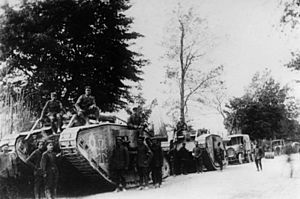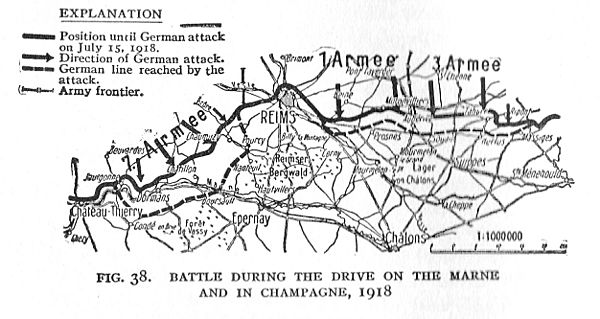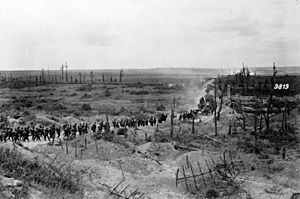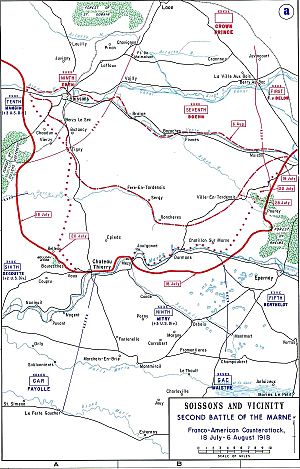Second Battle of the Marne facts for kids
{{Infobox military conflict | conflict = Second Battle of the Marne | partof = the Western Front of World War I | image = 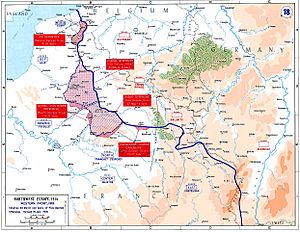 | caption = German offensives, 1918 | date = 15 July – 18 July 1918 | place = Marne River near Paris, France | coordinates = 49°5′N 3°40′E / 49.083°N 3.667°E | result = Entente victory | combatant1 = Entente Powers:
| caption = German offensives, 1918 | date = 15 July – 18 July 1918 | place = Marne River near Paris, France | coordinates = 49°5′N 3°40′E / 49.083°N 3.667°E | result = Entente victory | combatant1 = Entente Powers:
![]() France
France
![]() United States
United States
![]() United Kingdom
United Kingdom
![]() Italy
Italy
![]() Russia
Russia
![]() Kingdom of Siam | combatant2 = Central Powers:
Kingdom of Siam | combatant2 = Central Powers:
![]() German Empire | commander1 =
German Empire | commander1 = ![]() Ferdinand Foch
Ferdinand Foch
![]() Paul Maistre
Paul Maistre
![]() Émile Fayolle
Émile Fayolle
![]() Henri Gouraud
Henri Gouraud
![]() Charles Mangin
Charles Mangin
![]() Antoine de Mitry
Antoine de Mitry
![]() Henri Berthelot
Henri Berthelot
{{country data Jean Degoutte]]
![]() John J. Pershing
John J. Pershing
![]() Alexander Godley
Alexander Godley
![]() Alberico Albricci |flagicon/core|variant=|size=}} The Second Battle of the Marne happened from July 15 to July 18, 1918. It was the last big attack by Germany on the Western Front during World War I. The attack failed when the Allied forces fought back strongly. They used hundreds of tanks and surprised the Germans.
Alberico Albricci |flagicon/core|variant=|size=}} The Second Battle of the Marne happened from July 15 to July 18, 1918. It was the last big attack by Germany on the Western Front during World War I. The attack failed when the Allied forces fought back strongly. They used hundreds of tanks and surprised the Germans.
This German defeat was a major turning point in the war. It marked the start of the Allies' steady advance. This advance led to the end of the war about 100 days later. The war ended with the Armistice with Germany.
Contents
Why the Battle Happened
Germany had tried to win the war quickly with a big attack earlier in 1918. This attack, called the German spring offensive, did not work.
Erich Ludendorff, a top German military leader, still believed Germany could win. He thought an attack through a place called Flanders would defeat the British army. To hide his real plan, Ludendorff decided to launch a large fake attack. This attack was meant to draw Allied troops away from Belgium. This fake attack was the Second Battle of the Marne.
Germany's Attack Plan
The battle started on July 15. Twenty-three German divisions attacked the French Fourth Army east of Reims. This part of the battle was also known as the Fourth Battle of Champagne. At the same time, 17 other German divisions attacked the French Sixth Army west of Reims. This was called the Battle of the Mountain of Reims.
Ludendorff's goal was to split the French army into two parts. He hoped this would make them easier to defeat.
East of Reims, the French Fourth Army was ready. They had set up a "defense in depth." This means they had several lines of defense, not just one. Their main defense line was several kilometers behind the front. It was hidden from enemy view. Between the front and the main line were strong points. These were also mostly hidden.
The French knew the German attack was coming. Their planes had seen German preparations. They even learned the exact time of the attack from German prisoners. This helped them prepare even better.
The Germans planned to start their bombardment at 12:10 PM. But the French started firing at the German trenches at 11:30 AM. This surprised the German attackers. When the Germans finally fired, they mostly hit empty French front lines.
The German soldiers moved forward easily at first. They followed a "rolling barrage," which is a moving wall of gunfire. But they were slowed down by French strong points. When they reached the main French defense line, they had to stop. They waited for their own guns to move closer.
They attacked the main line the next morning but were stopped by strong French artillery fire. They tried again at noon but failed. The French Fourth Army was able to send help to their neighbors who were having a harder time.
In the west, German stormtroopers crossed the Marne River. They used small boats and rafts. They built temporary bridges under fire. Some Allied units, like the American 38th Infantry Regiment, fought very bravely. They held their ground or even attacked back.
By evening, the Germans had captured an area on the other side of the river. This area was about 6.5 km deep and 14.5 km wide. French bombers tried to stop them by dropping bombs on the bridges. But the Germans still managed to cross.
The French army received help from British and American troops. The German advance then stopped on July 17, 1918.
Allied Counter-Attack
The Germans failed to break through the Allied lines. This allowed Ferdinand Foch, the top Allied commander, to launch a big counter-attack. On July 18, 24 French divisions attacked. They were joined by American, British, and Italian troops. About 350 tanks also joined the attack. They targeted the German lines that had pushed forward.
The Allies were very well prepared. They knew a lot about the German attack plans. There is a story that an American engineer tricked the Germans. He left a briefcase with fake attack plans where the Germans would find it. The Germans believed these fake plans. They changed their own attack based on them.
Because of this, the French and American forces could attack a different part of the German lines. This left the Germans with no choice but to retreat. This battle marked the start of a German withdrawal that never really stopped.
The main force that defeated the German attack was French. But American, British, and Italian soldiers also helped a lot. It was hard to get all these different armies to work together. They had different languages, cultures, and fighting styles. However, the fresh American troops, who had not been fighting for years, greatly boosted the Allied forces.
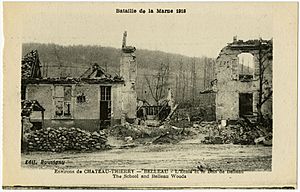
On July 19, Italian soldiers stopped a German attack on their positions. They lost many men but held their ground. British divisions also joined the fight alongside the Italians. This part of the battle was called the Battle of Tardenois.
The Germans ordered a retreat on July 20. They were forced back to where they had started their Spring Offensive. They tried to strengthen their defenses. By July 27, the Germans had pulled back further. They still held the town of Soissons in the west.
On August 1, French and British divisions attacked again. They advanced almost 8 km. The Allied counter-attack slowly ended by August 6. By this time, the German bulge in the lines had been reduced. The Germans were pushed back to a new line along the Aisne and Vesle Rivers. The front line was shortened by about 45 km.
What We Learned from the Battle
The Second Battle of the Marne was a very important victory for the Allies. Ferdinand Foch, the Allied commander, was given the rank of Marshal of France. The Allies captured many German prisoners, guns, and machine guns. The Germans suffered many casualties.
The most important thing about this battle was its effect on morale. It showed that the Germans could be defeated. It marked the end of German victories and the start of a series of Allied victories. These victories would lead to the end of the war in just three months.
See also
- First Battle of the Marne
- Memorial to the Second Battle of the Marne at the Butte de Chalmont
- Russian Expeditionary Force in France


